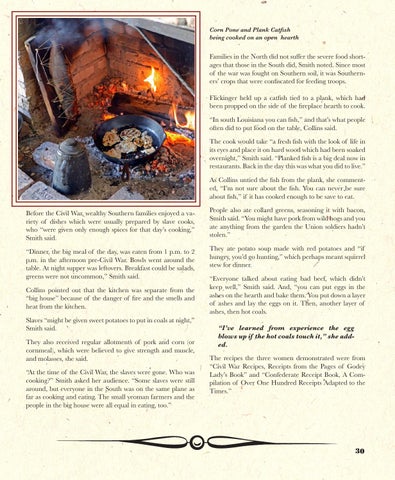Corn Pone and Plank Catfish being cooked on an open hearth
Families in the North did not suffer the severe food shortages that those in the South did, Smith noted. Since most of the war was fought on Southern soil, it was Southerners’ crops that were confiscated for feeding troops. Flickinger held up a catfish tied to a plank, which had been propped on the side of the fireplace hearth to cook. “In south Louisiana you can fish,” and that’s what people often did to put food on the table, Collins said. The cook would take “a fresh fish with the look of life in its eyes and place it on hard wood which had been soaked overnight,” Smith said. “Planked fish is a big deal now in restaurants. Back in the day this was what you did to live.” As Collins untied the fish from the plank, she commented, “I’m not sure about the fish. You can never be sure about fish,” if it has cooked enough to be save to eat. Before the Civil War, wealthy Southern families enjoyed a variety of dishes which were usually prepared by slave cooks, who “were given only enough spices for that day’s cooking,” Smith said.
People also ate collard greens, seasoning it with bacon, Smith said. “You might have pork from wild hogs and you ate anything from the garden the Union soldiers hadn’t stolen.”
“Dinner, the big meal of the day, was eaten from 1 p.m. to 2 p.m. in the afternoon pre-Civil War. Bowls went around the table. At night supper was leftovers. Breakfast could be salads, greens were not uncommon,” Smith said.
They ate potato soup made with red potatoes and “if hungry, you’d go hunting,” which perhaps meant squirrel stew for dinner.
Collins pointed out that the kitchen was separate from the “big house” because of the danger of fire and the smells and heat from the kitchen. Slaves “might be given sweet potatoes to put in coals at night,” Smith said. They also received regular allotments of pork and corn (or cornmeal), which were believed to give strength and muscle, and molasses, she said. “At the time of the Civil War, the slaves were gone. Who was cooking?” Smith asked her audience. “Some slaves were still around, but everyone in the South was on the same plane as far as cooking and eating. The small yeoman farmers and the people in the big house were all equal in eating, too.”
“Everyone talked about eating bad beef, which didn’t keep well,” Smith said. And, “you can put eggs in the ashes on the hearth and bake them. You put down a layer of ashes and lay the eggs on it. Then, another layer of ashes, then hot coals. “I’ve learned from experience the egg blows up if the hot coals touch it,” she added. The recipes the three women demonstrated were from “Civil War Recipes, Receipts from the Pages of Godey Lady’s Book” and “Confederate Receipt Book, A Compilation of Over One Hundred Receipts Adapted to the Times.”
30
